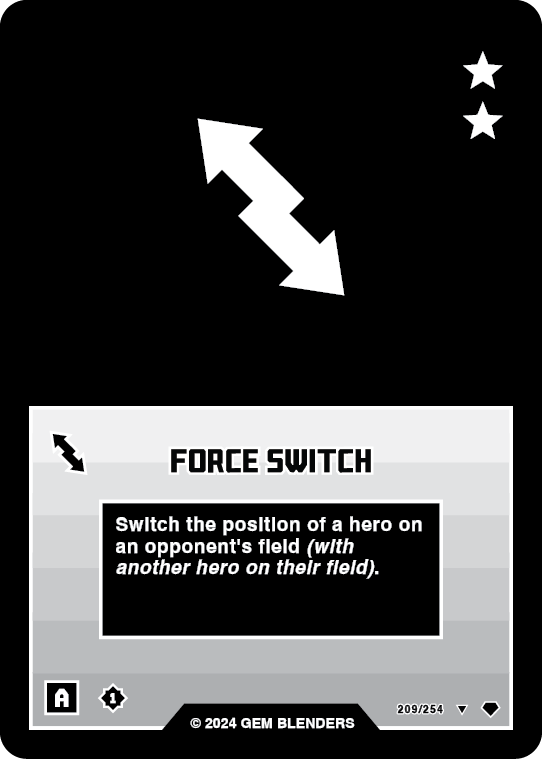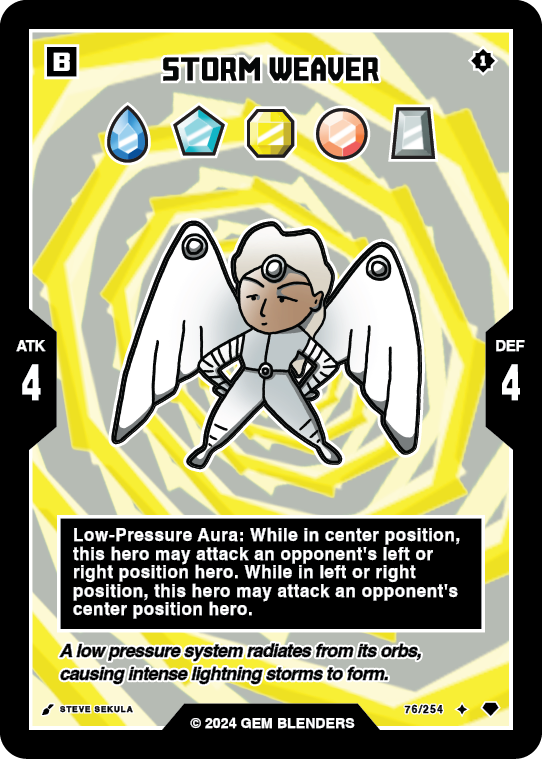Do you ever feel like your decks are good, but your gameplay could be better? This definitive guide will go over some high-level competitive gameplay tips to give you the edge in upcoming tournaments.
Table of Contents
1. Mulligans
Knowing whether to mulligan is a really valuable skill, as it can give you the starting hand you need to set up properly. Unlike in some other TCGs, mulligans in Gem Blenders aren’t punished – you get a new set of seven cards – but are far more limited, given that you can only do one. You might choose to mulligan and get no gems. Given this, when should you take a mulligan?
Try to count how many cards in your hand will be useful to you in your first four or five turns. Lower level blends are more useful in the beginning, and high level blends are wasted hand space until much later. Single combo pieces like Chain Smoker or Data Cipher on their own, repeats of cards, late-game effects like Amplify, Fleet Reacher, or Flush are often going to be less useful in your starting hand. In the same way, many cards are going to lose value as the game continues, like Surges and Collects, which might be better in your starting hand.
Given that you know what you have in your hand and what you can guarantee to search out with heroes (like Selma or Fatima), but you don’t know what you’re going to draw, try to analyze how much you could do without drawing any more cards. If the answer is nothing, then a mulligan might be necessary. It’s also important to see if you have any way to cycle through cards. If you have a useless card but also a Draw or Fowl, that makes the hand much better to keep.
2. Deck Thinning
A somewhat minor concept that’s worth keeping in mind. It’s based on the idea that the fewer cards there are in your deck, the more likely you are to find a certain card you need. A card like Mage is able to clear your deck of two gems, allowing you to draw into more impactful cards in your future turns. Cards like Hickory allow for repeatable thinning.
Say you have 33 cards in your deck – even if you don’t need Cryogems, an Ice Creamer can make it so you have a 3/33 chance to draw the blend you need instead of a 3/36 chance. It’s minor, but important.
It’s also helpful when ordering effects. If you have a Draw and a Gem Search, it’s better to use the Draw first, because you might hit the gem you wanted and be able to save your gem for later. Also, if you need two gem types and have played a Gem Search, grab the one that there are less of, so you are more likely to draw into the other.
3. How to Collect
Collect is a great card – it allows you to plan ahead and get what you need, but works best when paired with a shuffle effect. Without any way to shuffle, you might get stuck with cards you don’t need. If you collect and see that two of the cards are useful and two are not, put one into your hand, wait until you draw next, and then shuffle the useless cards back into your deck with an action or effect. Hickory is great at this – as long as you have two gems on him, you can always search your deck and fail to find (not take anything out of your deck), even if you know there aren’t any more eligible blends.


4. How to Cancel
Or rather, when to Cancel. A well-timed Cancel (or Super Cancel) can save your life, but a poorly timed one just fills up a slot in your action meter. The main thing to ask yourself is: how much does my opponent need this action? If an action is essential to someone’s plan, like an Amplify combo or Recycle loop, a Cancel will provide a lot of value. If the action has the ability to ruin your plan, like a Force Switch that you don’t have an answer to, a Super Cancel might be necessary to save yourself. Just because the action is high-starred or flashy doesn’t mean you always have to cancel it. A Cancel to a needed Gem Search can throw off your opponent for many turns. If the action is giving them something to set up their plan, it might be worth cancelling. Look out for signs of desperation, like missing gem drops or important blends.
It’s also important to keep an eye out on both action meters. If your opponent has 4 actions already, not cancelling will prevent them from playing any more actions for the round. This is especially important in a Cancel chain – the loser of a Cancel chain discards their cancelled actions, while the winner’s fill up their action meter.


5. Watch Your Opponent
It sounds simple, but it’s important to pay attention to everything your opponent does. Try to figure out their plan as early as possible so you know how to counteract it. If your opponent is going fast, you might want to prioritize getting defense up. If they are building up in the back, you might want to try to get damage fast. You can infer what cards your opponent has or doesn’t have based on what they do. If they search for an Usher, they most likely have a lot of gems in hand.
With this comes expecting what interaction your opponent will play. It’s worth imagining the worst thing that could happen. Will your opponent play a Force Switch? Surge into their combo a turn early? Silent Usher into an attacker? In addition to expecting what your opponent will most likely do, you should imagine the more extreme but possible outcomes and prepare for them, so you’re not shocked when something unexpected happens.
6. Clocks and Power Balance


An important concept, especially in Gem Blenders, are “clocks,” or in other words how many turns each player has left to live. Given the limited capacity for damage output because of the three lane combat system, it’s easy to understand how much damage each player will take every turn, given nothing changes. Taking your HP total and dividing it by the amount of damage you will take per turn gives you the amount of turns you have left to live. Make sure to keep an eye on the current state of both clocks.
Whoever currently has a faster clock has the aggressive power, and their opponent must act as the control player, trying to get defense or stun or discard the aggressive player’s heroes and blends. Keeping in mind this power dynamic, try not to get bogged down based on what your deck is “supposed to do.” If you’re playing a slower deck but happen to be doing consistent relevant damage with heroes or low level blends, it might be worthwhile to lean into that.
It’s also important to predict what cards you and your opponent are able to play, and how that would change the pace of the clock. Understanding the blends they could play based on the gems they have is helpful in predicting how clocks will change.
7. Deblend-to-Block
When looking at clocks as well as just planning how you are going to attack, it is imperative to remember that you or your opponent can deblend-to-block. There are a few important things to keep in mind:
You rarely want to deblend something on your turn – it’s often better to save it to deblend-to-block when your opponent attacks next.
Deblending-to-block is particularly strong when against something that does one big attack but isn’t consistent, as you won’t get hit as hard in your now empty lane.
Deblending-to-block only blocks one attack, so consider that when playing with or against cards like Blood Reaper or Storm Weaver.


8. Better Benching
Ideally, your bench should contain answers to threats that aren’t worth answering in your main deck. Heroes like Peyton, Brenna, and Marci allow you to stun, cancel, and switch, which can help get you out of sticky situations. Sometimes, if you are losing, it is better to lose the round faster such that you can access your bench sooner in the game.
It is often bad to rely on a benched hero as part of your plan, like needing a level 5 hero. This is because 1) you lose out on answers to threats, as previously mentioned, and 2) a game can sometimes get stuck, or the first round can often take longer than you planned for. If this happens, you want to be able to play your deck to the fullest. Only have a bench hero as your main plan if it is absolutely necessary.
9. Know the Meta
Perhaps the most important of all, especially for big tournaments like the Invitational. You have to know what decks people are playing. First, see what decks are winning at other tournaments. Read Ben’s 2024 Invitational Meta Analysis. Outside of knowing the current popular set of decks, you should also know the main types of deck: each level 5 blend and the deck it would have, each synergy or combo, each level 2 blend and its deck (i.e. 3 Rams, Anchors, or Guards). The more you play and build your own decks, the more you will know about each deck.
Additionally, identify what deck your opponent is playing as soon as possible and understand how the matchup works – does either player have a weakness, and who is more aggressive?
And that’s it! Keep these tips in mind so you can rise to the top of your next tournament.
